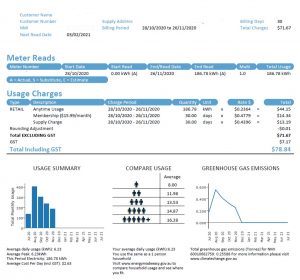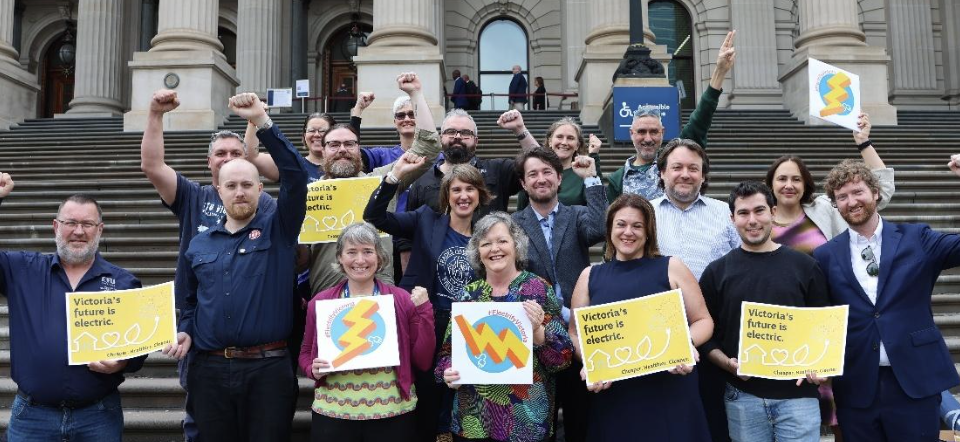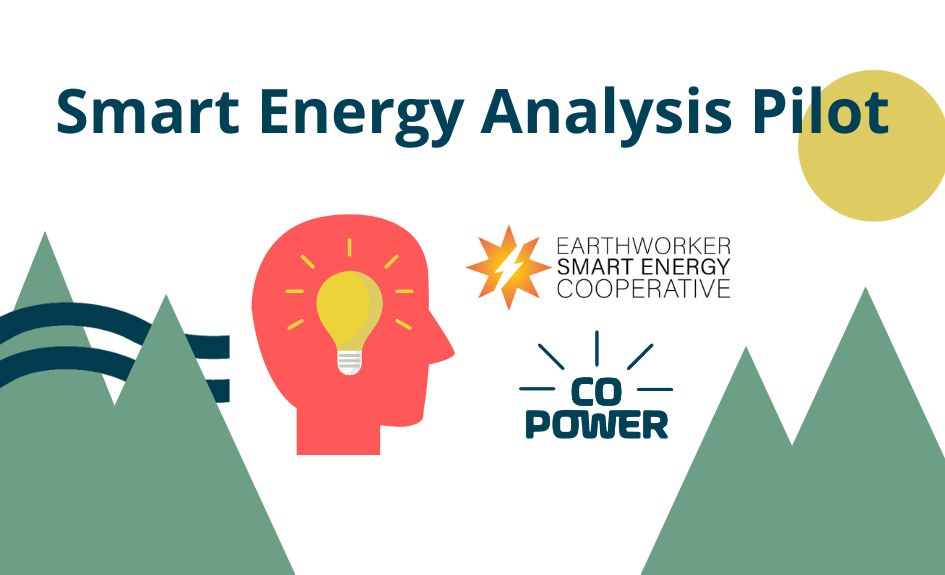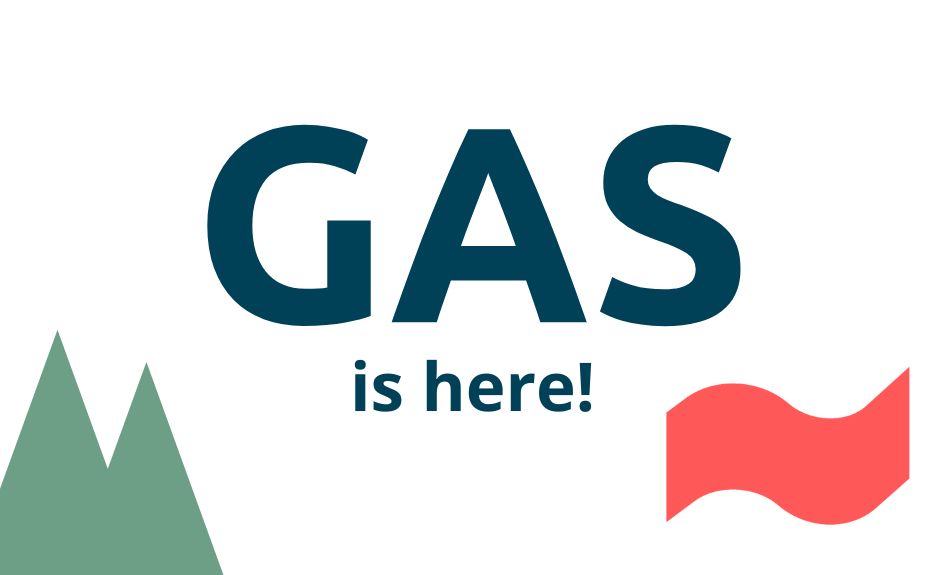Understanding your electricity bill

The Co-operative Way Podcast
December 11, 2020
Simple energy efficiency
May 28, 2021We all use electricity when we turn on lights, televisions, computers, charge a phone and other appliances. Many homes have electric hot water systems or heatpumps. Some homes and workplaces are installing electric vehicle chargers. Victoria and other states and territories are increasingly moving towards replacing gas with renewable electricity for heating, cooking and hot water to reduce greenhouse gas emissions.
Understanding your electricity bill gives you more control over how you use this vital service. Remember simple energy efficiency measures can help you save money. And help is available if you are having trouble paying your bill.
Please note the images of an electricity bill provided on this page are an example only and is not your actual bill.
 What’s on your bill?*
What’s on your bill?*

Your name, address, other identifying account details and the Due Date by which the bill should be paid. How much you owe is the Opening Balance (amount owing on previous bill – any payments) plus new account charges. Page 2 (see below) details the new charges and other information.
Page 2

Top Section
Customer Name: The name registered by Cooperative Power for your account.
Customer Number: Unique number Cooperative Power uses to identify you as a customer.
Supply Address: Where the electricity is supplied. This can be different from your home address.
Billing Days: The number of days covered by this bill. This is used to calculate the total for daily charges (see below) for this bill.
NMI: The National Meter Identifier uniquely identifies this connection to the electricity grid at your supply address. You can use the NMI to access your past electricity consumption data through Cooperative Power and other sources. This is useful if you want to install solar, look for changes in your consumption, see when you use power during the day and at different times of the year and other investigations.
Billing Period: Calendar period covered by this bill.
Total Charges: Charges within this bill before GST. (See below.).
Next Read Date: When your meter will next be read to see how much electricity has been used at this Supply Address.
Meter Reads
Meter Number: Identifier for the electricity meter that measures how much electricity this account uses.
Start Date: The start date for the Billing Period covered by this bill.
Start Read: The kWh reading at the start of the Billing Period.
End Read/Date: The end date for the Billing Period covered by this bill.
End Read: The kWh reading at the end of the Billing Period.
Multi: This should generally be 1 on a retail bill. The readings on some meters at commercial and industrial sites are multiplied by the Multi value to calculate the kWh for the bill.
Total Usage: The End Read minus the Start Read times the Multi value is the amount of electricity in kWh you will be charged for in this bill.
A = Actual, S = Substitute, E = Estimate: A means the Read is an actual value whereas an S or E means the Read is estimated.
Usage Charges
Type: Cooperative Power currently supplies retail customers. This may change to include commercial and industrial customers in the future
Description: The type of charge. This bill has the following charges:
- Anytime Usage: This is the name of the tariff that applies to this Charge Period. Tariffs can be quite complex with different rates for time of day, week and season, discounts and other components. This tariff simply has the same Rate (cost/KWH) = $0.2364 for all hours. The tariff cost Total is the Quantity of kWhs x the Rate. kWhs are the Unit for the tariff charge.
- Membership ($15.99/month): For the Charge Period (30 days in November) the Rate for the day Unit is calculated by multiplying the monthly charge of $15.99 by 12 and dividing by 365 days in a year. The Total is the Rate of $0.4779 is multiplied by the 30 days.
- Supply Charge: For the Charge Period (30 days in November) the daily Supply Charge Rate $0.4396 is multiplied by days to calculate the Total.
Charts and Table
USAGE SUMMARY chart:
Large differences in the monthly values in the Usage Summary Chart indicate changes in how you are using electricity. These changes might be expected due to higher use of electricity for seasonal heating and cooling or more or less people living in a house but can also indicate issues that might need attention.
Average Daily Usage (kWh): The total number of kWhs used in this Billing Period divided by number of days in the Billing Period.
Average Peak: As this customer is on a single rate tariff all the power used is included in the peak period total.
This Period Electricity: The total electricity used in the Billing Period.
Average Cost Per Day (incl GST): The total cost including GST for this Billing Period divided by the number of days.
COMPARE USAGE: Compares the Average daily usage (kWh) against the average expected for households with 1 – 5+ based on government estimates. This can show whether your household is using more or less electricity than other similar households.
GREENHOUSE GAS EMISSIONS: The estimated greenhouse emissions for the electricity used during this Billing Period using government greenhouse emission figures.
Other Cooperative Power bill items not on this customer’s bill
Concessions: Any energy concessions applied to your account should appear as a credit against charges.
Solar: Solar generation in excess of your usage will appear as a credit against charges. The credit is computed as the export quantity x the feedin tariff.
* Notes:
- The bill excerpts are from a real Cooperative Power customer bill. We’ve blanked some details to preserve the customer’s privacy.
- kWhs pop up a lot in electricity bills. This abbreviation causes a great deal of confusion to folks who don’t spend all day long doing energy. kW is an abbreviation of kilowatt or thousand watts. kW is used to measure how much electricity an appliance is using. A 1kW heater needs 1kW of electricity supply to run. kWh is the energy consumed by that appliance over time. A 1kW heater running for 2 hours will use 1kW x 2hours = 2kWh worth of energy.




